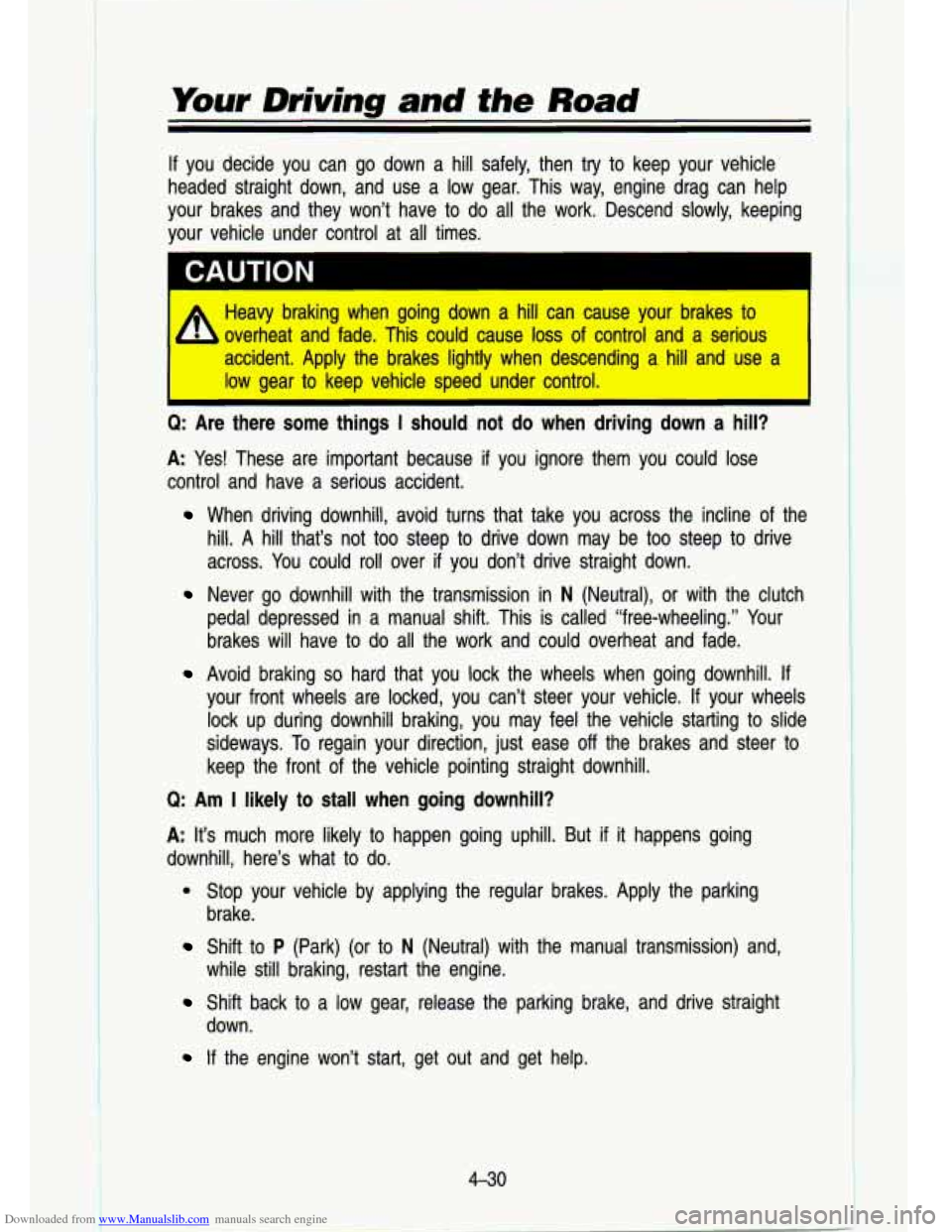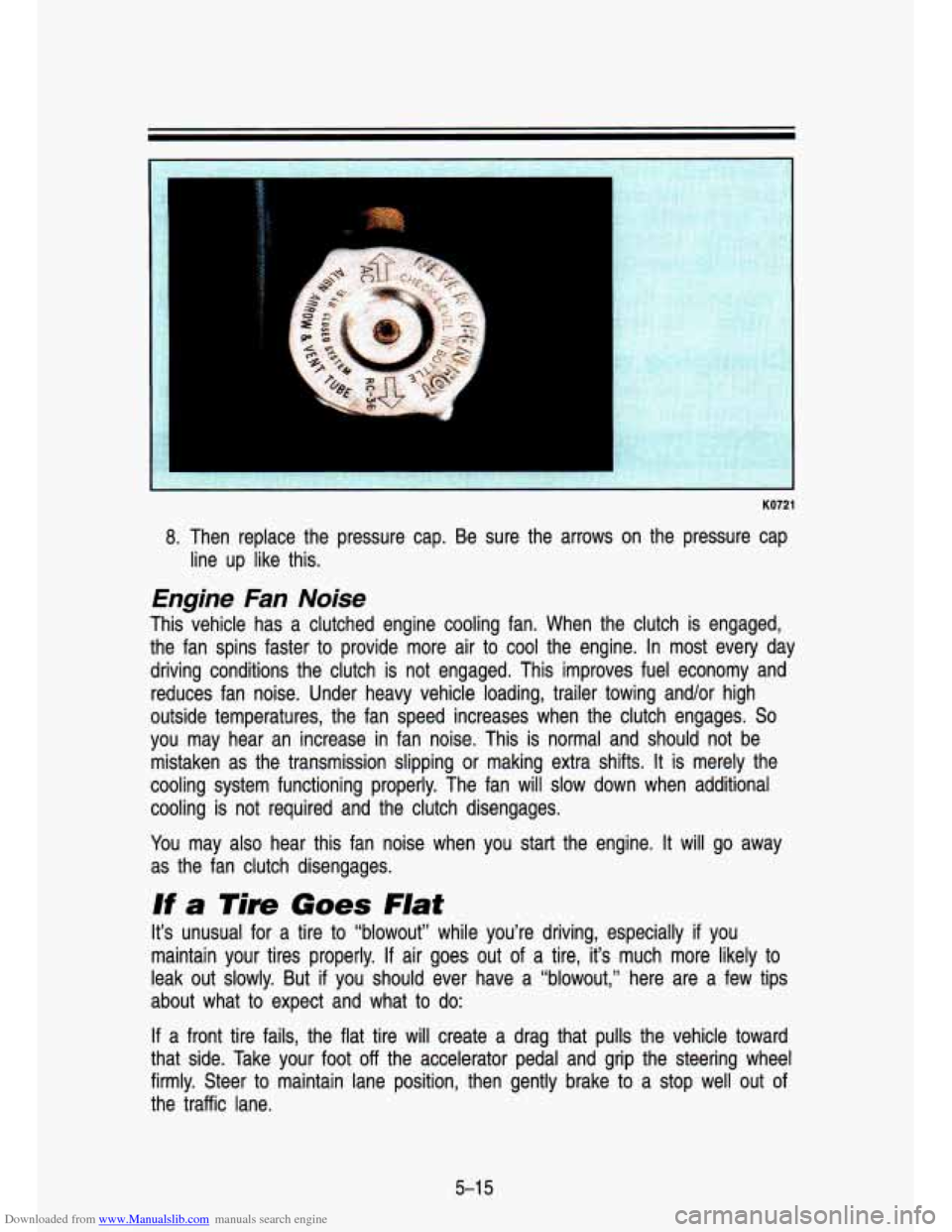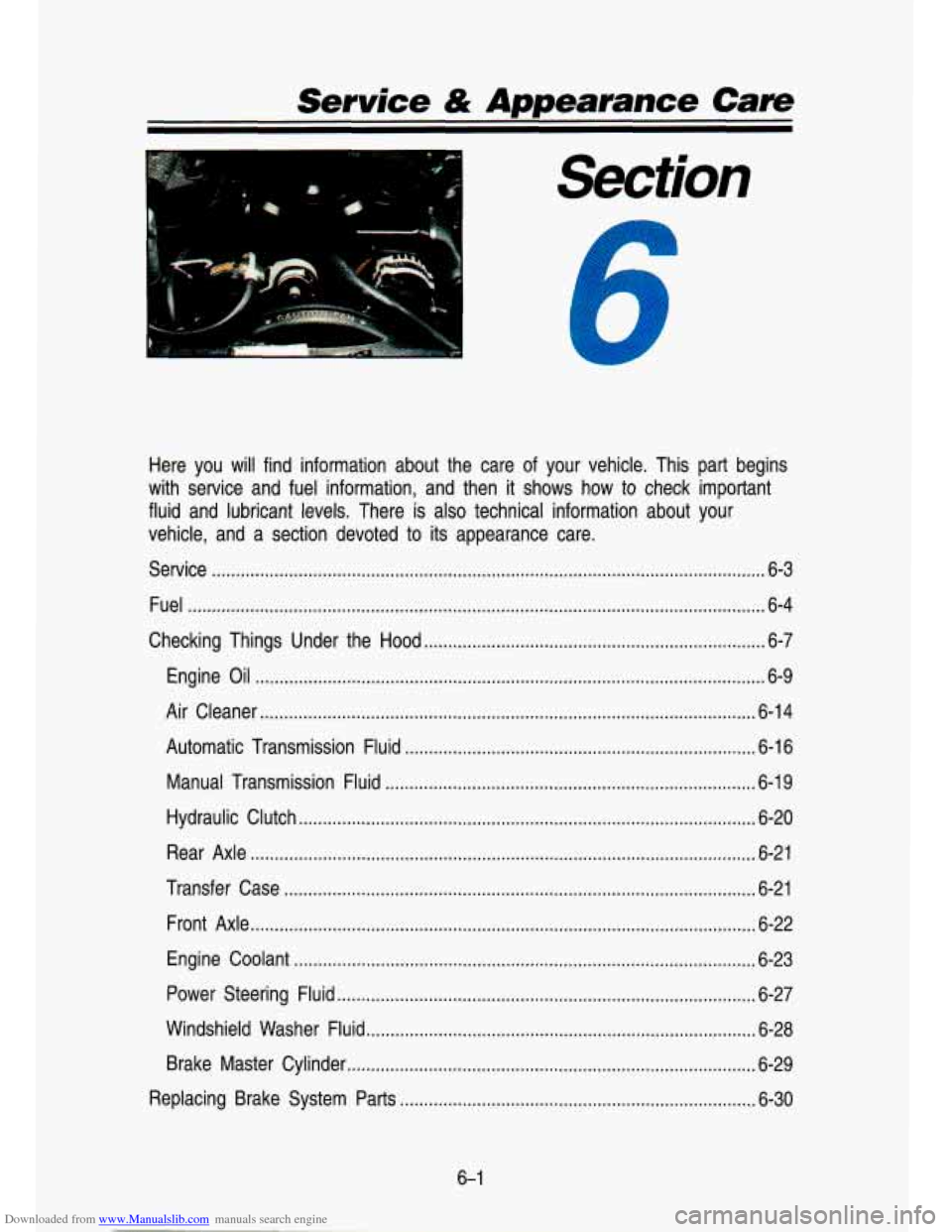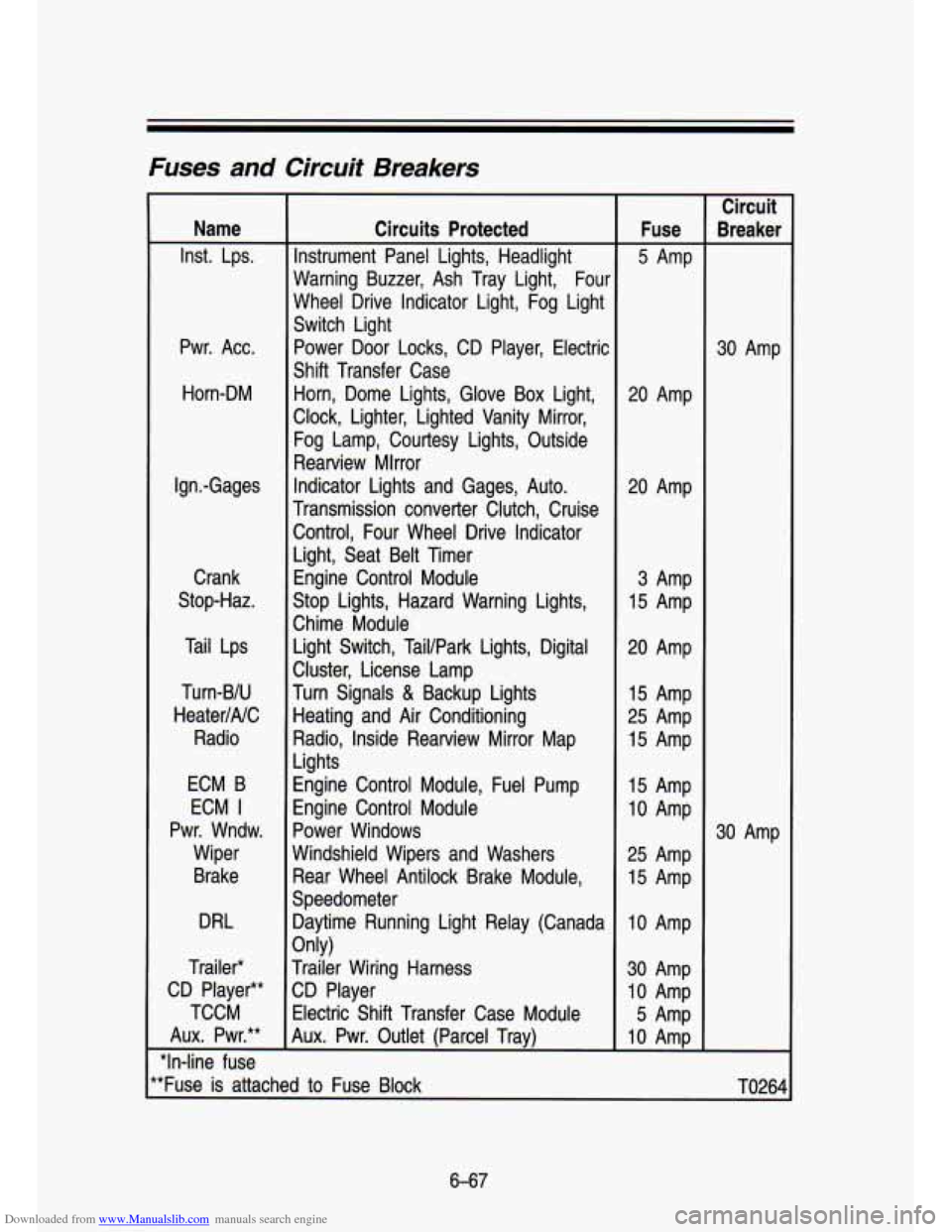1993 CHEVROLET S10 clutch
[x] Cancel search: clutchPage 184 of 356

Downloaded from www.Manualslib.com manuals search engine Your Driving and the Road
If you decide you can go down a hill safely, then try to keep \
your vehicle
headed straight down, and use a low gear. This way, engine drag can help
your brakes and they won’t have to do all the work. Descend slowly, keeping
your vehicle under control at all times.
A
Heavy braking when going down a hill can cause your brakes to
overheat and fade. This could cause
loss of control and a serious
accident. Apply the brakes lightly when descending a hill and use a
low gear to keep vehicle speed under
1 control.
Q: Are there some things I should not do when driving down a hill?
A: Yes! These are important because
if you ignore them you could lose
control and have a serious accident.
When driving downhill, avoid turns that take you across the in\
cline of the
hill. A hill that’s not too steep to drive down may be too steep to drive
across. You could roll over
if you don’t drive straight down.
Never go downhill with the transmission in N (Neutral), or with the clutch
pedal depressed in a manual shift. This is called “free-wheeling.” Your
brakes will have to do all the work and could overheat and fade.
Avoid braking so hard that you lock the wheels when going downhill. If
your front wheels are locked, you can’t steer your vehicle. \
If your wheels
lock up during downhill braking, you may feel the vehicle starting to slide
sideways.
To regain your direction, just ease off the brakes and steer to
keep the front of the vehicle pointing straight downhill.
Q: Am I likely to stall when going downhill?
A: It’s much more likely to happen going uphill. But if it happens going
downhill, here’s what to do.
* Stop your vehicle by applying the regular brakes. Apply the parking
brake.
Shift to P (Park) (or to N (Neutral) with the manual transmission) and,
while still braking, restart the engine.
Shift back to a low gear, release the parking brake, and drive straight
down.
4-30
If the engine won’t start, get out and get help.
Page 231 of 356

Downloaded from www.Manualslib.com manuals search engine KO721
8. Then replace the pressure cap. Be sure the arrows on the pres\
sure cap line up like this.
Engine Fan Noise
This vehicle has a clutched engine cooling fan. When the clutch is engaged,
the fan spins faster to provide more air to cool the engine. In most every day
driving conditions the clutch is not engaged. This improves fue\
l economy and
reduces fan noise. Under heavy vehicle loading, trailer towing andlor high
outside temperatures, the fan speed increases when the clutch e\
ngages.
So
you may hear an increase in fan noise. This is normal and should not be
mistaken as the transmission slipping or making extra shifts.
It is merely the
cooling system functioning properly. The fan will slow down whe\
n additional
cooling is not required and the clutch disengages.
You may also hear this fan noise when you start the engine. It will go away
as the fan clutch disengages.
If a Tire Goes Flat
It’s unusual for a tire to “blowout” while you’re d\
riving, especially if you
maintain your tires properly.
If air goes out of a tire, it’s much more likely to
leak out slowly. But if you should ever have a “blowout,”\
here are a few tips
about what to expect and what to do:
If a front tire fails, the flat tire will create a drag that pu\
lls the vehicle toward
that side. Take your foot off the accelerator pedal and grip the steering wheel
firmly. Steer to maintain lane position, then gently brake to \
a stop well out of
the traffic lane.
5-1 5
Page 249 of 356

Downloaded from www.Manualslib.com manuals search engine Service & Appearance Care
-
Section
Here you will find information about the care of your vehicle. This part begins
with service and fuel information, and then it shows how to check important
fluid and lubricant levels. There
is also technical information about your
vehicle, and a section devoted to its appearance care.
Service
.. . . .. . . . . , . , . . r.l. .. . . .. ,. . . . . . . . . , , . . . . . . .. , . . .. , . . . . . . . . . . . . . . . . . . . . ..,. . . . . . . . . . . . . . . .=. . . . . . . . . . . . .. . .=. . . . . 6-3
Fuel
...... . .. .. . . . . ....... , .. . .. . . . . . . ... . .. ... .. ... .... .. . . . . . . ... . . .. . .. . ... ,..,, ,. .. . .. .. . .. . . .... . *. . . ., . . . .. .. .. 6-4
Checking Things Under the
Hood .................................................................,..... \
6-7
Engine Oil
I.....................1............11..........,.......,.,..I...........\
........r............. .......,. .... 6-9
Air Cleaner
..................,................................................. ...... .... ...- ......... - ..... ...... 6-14
Automatic Transmission Fluid
....... . .. . . .. . . . . .. ....-. . ... . . . . . .. .. . . . . . . . . . ... .. . . . . .. . ... . . ...... .. 6-16
Manual Transmission Fluid
....,. , . . . . ....... ... . . . .. .. . . . .. .. . .. .. . . ... . .. . . . . .. . ... . ... . . ... . . ... . . . .. 6-1 9
Hydraulic Clutch
,..........,......,....,..........I...I....I...................... ...................... ..... 6-20
Rear Axle
............ ..................... = .............I...............I..I........................ -.. ..... . .... ..... 6-21
Transfer Case
................................................,.~.....................\
..........................6-21
Front Axle .......I.............I......I.....................r..........I...r......\
............I......I.II...I...... 6-22
Engine Coolant
........................... ~ ................................. r..l ................................ 6-23
Power Steering Fluid
.....,. 3.,Iri.1111r ..................................................................... 6-27
Windshield Washer Fluid
...................................................... .................... 6-28
Brake Master Cylinder
........ . . . . .. . .... . .. .. . . . . ... . . . . .. . . . .. ..... .... . . . . . . . .. .. . . . . . .6-29
Replacing Brake System Parts
............................................................,..........,\
.. 6-30
6-1
Page 268 of 356

Downloaded from www.Manualslib.com manuals search engine Service & Amearance Cam
How to Add Fluid:
Here’s how to add fluid. Refer to the Maintenance Schedule to determine
what kind of fluid to use. See “Recommended Fluids and Lubricants” in the
Index.
1. Remove the filler plug.
2. Add fluid at the filler plug hole. Add only enough fluid to bring the fluid
3. Install the plug. Be sure it is fully seated.
level up to the bottom
of the filler plug hole.
Hydraulic Clutch
The hydraulic clutch in your vehicle is self-adjusting. A slight amount of play
[1/4
(6 mm)-112 inch (13 mm)] in the pedal is normal.
When to Check and What to Use:
i
c
PO257 I
Refer to the Maintenance Schedule to determine how often you s\
hould check
the fluid level in your clutch master cylinder reservoir and w\
hat to add. See
“Owner Checks and Services” and “Recommended Fluids and \
Lubricants” in
the Index.
How to Check:
The proper fluid should be added if the level does not reach the bottom of
the diaphragm when it’s in place in the reservoir. See the
instructions on the
reservoir cap.
6-20
Page 282 of 356

Downloaded from www.Manualslib.com manuals search engine Service & Appearance Care
Other Maintenance Items
Hydraulic Clutch Grease Fitting
If you have the 4.3L (VIN code Z) engine with a manual transmission, a
grease fitting is on the clutch housing for lubricating the cl\
utch fork ball stud.
Refer to the Maintenance Schedule for information on how to lu\
bricate the
clutch housing, and what type of lubricant to use. Be sure no\
t to over-fill
because you could
damage your clutch.
Front Suspension and Steering Linkage
Refer to the Maintenance Schedule to determine how often to lubricate the
fittings and what type of lubricant to use.
Front Wheel Bearings (Two-Wheel Drive)
If your vehicle is two-wheel drive, it has wheel bearings that mu\
st be cleaned
and repacked.
Refer
to the Maintenance Schedule to determine how often this must be
done.
Single Belt Accessory Drive
Your new vehicle uses a serpentine belt that is lighter, and more durable than
systems with several belts.
The belt runs over or around the pulleys
on the engine. A tensioner is used
to keep the belt tight at all times. The tensioner also makes replacing the
belt easier.
If you need to replace the belt, be sure to get the correct
replacement belt. Your dealership or parts supplier can help yo\
u with this.
The Accessory Drive Belt Routing label on your vehicle will sh\
ow you how to
route the belt your vehicle uses.
6-34
Page 315 of 356

Downloaded from www.Manualslib.com manuals search engine Fuses and Circuit Breakers
Name
Inst. Lps.
Pwr. Acc. Horn-DM
Ign.-Gages Crank
Stop-Haz.
Tail Lps
Turn-BIU
HeaterINC Radio
ECM B
ECM
I
Pwr. Wndw. Wiper
Brake
DRL
Trailer*
CD Player**
TCCM
Aux. Pwr.**
"In-line fuse Circuits Protected
Instrument Panel Lights, Headlight
Warning Buzzer, Ash Tray Light, Four
Wheel Drive Indicator Light, Fog Light
Switch Light Power Door Locks, CD Player, Electric
Shift Transfer Case Horn, Dome Lights, Glove Box Light,
Clock, Lighter, Lighted Vanity Mirror,
Fog Lamp, Courtesy Lights, Outside
Rearview Mlrror
Indicator Lights and Gages, Auto.
Transmission converter Clutch, Cruise Control, Four Wheel Drive Indicator
Light, Seat Belt Timer Engine Control Module
Stop Lights, Hazard Warning Lights,
Chime Module Light Switch, Tail/Park Lights, Digital
Cluster, License Lamp
Turn Signals
& Backup Lights
Heating and Air Conditioning
Radio, Inside Rearview Mirror Map
Lights
Engine Control Module, Fuel Pump
Engine Control Module
Power Windows
Windshield Wipers and Washers Rear Wheel Antilock Brake Module,
Speedometer Daytime Running Light Relay (Canada
Trailer Wiring Harness
CD Player
Electric Shift Transfer Case Module
Aux. Pwr. Outlet (Parcel Trav)
Only) Fuse
5 Amp
20 Amp
20 Amp
3 Amp
15 Amp
20 Amp 15 Amp
25 Amp
15 Amp
15 Amp
10 Amp
25 Amp
15 Amp
10 Amp
30 Amp
10 Amp
5 Amp
10 AmD Circuit
kea ker
30 Amp
30 Amp
'*Fuse is attached to Fuse Block
TO264
6-67
Page 320 of 356

Downloaded from www.Manualslib.com manuals search engine Scheduled Maintenance Services
SCHEDULED MAINTENANCE SERVICES FOR
I
If your driving conditions meet those specified i
Services” in this Section (or see Index), use
M
Item I I Miles (000) I 3 I 6
No. Service Kilometers (000) 5 10
1 Engine Oil Change*
I -Even/ 3 Months, or
Oil Filter Change*
-Every 3 Months, or
tt
2 Chassis Lubrication-Every 12 Months,
,, Clutch Fork Ball Stud Lubrication (4.3L or J I engines only) I
4 Cooling System Service*-Every 24
1 Months or
5 I Air Cleaner Filter Replacement* I I
6 Front Wheel Bearing Repack (2WD
Only)
7 Transmission Service**
8 Fuel Filter Replacement*
9 Spark Plugs Replacement*
10 Spark Plug Wire Inspection*
11 Engine Timing Check*
12 Fuel Tank, Cap and Lines Inspection*
13 Engine Accessory Drive Belt Inspection*
14 Tire and Wheel Rotation
t
15 Drive Axle Service tt
16 Brake Systems Inspection**
FOOTNOTES:
*An Emission Control Service
**See “Explanation
of Scheduled Maintenapce Services” i n the Index
TO283
7-4
Page 322 of 356

Downloaded from www.Manualslib.com manuals search engine scheduled Maintenance Services
I
SCHEDU--D MAIM 4ANCE SEf -7s FOR
If your driving conditions meet those I
Services” in this Section (or see lnde
Item Miles
(000)
No. Service Kilometers (000)
1 Engine Oil Change*
Oil Filter Change* -Every 12 Months,
or
-Every
12 Months, or
2 Chassis Lubrication-Every 12 Months, or
Clutch Fork Ball Stud Lubrication (4.3L
engines only)
Months or
3
4 Cooling System Service*-Every 24
5 Air Cleaner Filter Replacement*
6 Front Wheel Bearing Repack (2WD
7 Transmission Service**
8 Fuel Filter Replacement*
9 Spark Plugs Replacement*
10 Spark Plug Wire Inspection* 11 Engine Timing Check*
12 Fuel Tank, Cap and Lines Inspection*
13 Engine Accessory Drive Belt Inspection*
14 Tire and Wheel Rotation
15 Drive Axle Service
16 Brake Systems Inspection**
Only)
FOOTNOTES:
*An Emission Control Service
36
5 10
**See “Explanation of Scheduled Maintenance Services” in the Index
TO287
7-6